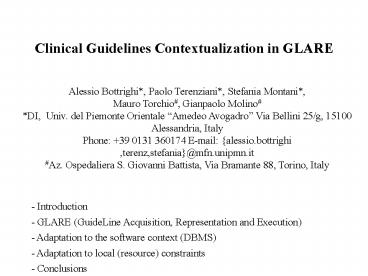Clinical Guidelines Contextualization in GLARE PowerPoint PPT Presentation
Title: Clinical Guidelines Contextualization in GLARE
1
Clinical Guidelines Contextualization in GLARE
Alessio Bottrighi, Paolo Terenziani, Stefania
Montani, Mauro Torchio, Gianpaolo MolinoDI,
Univ. del Piemonte Orientale Amedeo Avogadro
Via Bellini 25/g, 15100 Alessandria, ItalyPhone
39 0131 360174 E-mail alessio.bottrighi
,terenz,stefania_at_mfn.unipmn.itAz. Ospedaliera
S. Giovanni Battista, Via Bramante 88, Torino,
Italy
- Introduction
- GLARE (GuideLine Acquisition, Representation
and Execution)
- Adaptation to the software context (DBMS)
- Adaptation to local (resource) constraints
- Conclusions
2
Introduction
Clinical guidelines are a means for specifying
the best clinical procedures and for
standardizing them
Adopting (computer-based) clinical guidelines is
advantageous
Different roles - support - critique - evaluation
- education - ...
Many different computer systems managing clinical
guidelines (e.g., Asgaard, GEM, Gliff, Guide,
PROforma,)
3
Introduction
Obstacles to CGL use and dissemination gap
between CGL generality and the peculiarities of
contexts of application
General CGL PRO ? general, consensus,
standard CONS ? difficult application (local
constraints)
Local (e.g., Hospital) CGL PRO ?
applicability CONS ? no generality, no standard,
non sharable
GLAREs approach Semi-automatic adaptation of
general CGL PRO ? general, consensus, standard
PRO ? applicability
4
IntroductionContext Adaptation
(1) CONTEXT LOCAL RESOURCES - Availability of
tools for laboratory test investigations - also
costs and/or time Only CGL actions whose
resources are locally available can be executed
(2) CONTEXT LOCAL SOFTWARE ENVIRONMENT
(DBMS) - CGL acquisition and execution sw tools
must interact with HIS CGL sw tools should be
adapted to interact with different DBMS
5
GLARE(GuideLine Acquisition Representation and
Execution)
- Joint project Dept. Comp. Sci., Univ.
Alessandria (It) P. Terenziani, S.Montani,
A.Bottrighi Dept. Comp. Sci., Univ. Torino (It)
L.Anselma,G.Correndo Az. Osp. S. Giovanni
Battista, Torino (It) G.Molino, M.Torchio
- Domain independent (e.g., bladder cancer,
reflux esophagitis, heart failure) - Phisician-ori
ented User-friendly
Some recent pubblications Terenziani et al.,
AIIMJ 01,07a,07b, AMIA 00,02,03, Medinfo 04,
CGP04a,04b, AIIA 03,05, GIN 04,05, AIME
05a,05b,05c
AMIA06 posters T020 and T120 AMIA06 paper in
session S52
6
Representation Formalism
Tree of graphs
Atomic actions
Composite actions (plans)
Control relations between actions - sequence - c
ontrolled - alternative - repetition (e.g. 3
times each 2 days for a month)
7
Representation FormalismHierarchy of Action Types
Action
Plan
Work action
Query
Conclusion
Decision
Clinical action
Pharmacol. prescription
Diagnostic decision
Therapeutic decision
8
Representation Formalismdescription of a
clinical action
9
GLARE (main features)
- Acquisition Tool
- Facilities for syntactic semantic consistency
checking - Temporal constraints
- Execution Tool
- Facilities for decision making (hipothetical
reasoning facility) - Temporal constraints
- Interaction with HIS
- during acquisition
- during execution
- Testing bladder cancer, reflux esophagitis,
heart failure, ischemic stroke
10
GLARE (Graphical interface)
11
Adaptation to the sw contextGLAREs
three-layered architecture
12
Intermediate XML layer
XML as an interlingua (legibility, web,
dissemination)
XML layer and DBMS layer manage the same
knowledge, but support different functionalities
13
Three-layered architectureADVANTAGES
Exploiting an intermediate sharable format (XML)
and the DBMS technology to manage large amount of
data
Making the interaction with users more efficient
(QloadQstore vs LoadStore)
Making GLARE (mostly) independent of the DBMS
used for HIS - the interaction of GLARE with DBMS
mediated by the XML layer - changing the DBMS ?
changing only the (Java) module managing the
interaction between the XML layer and the DBMS
14
Adaptation to the local contextresources
MAIN IDEA Pre-compilation module INPUT
general CGL, list of local resources OUTPUT
CGLcontext
CGLcontext adaptation of CGL to the local
context only locally executable paths (actions)
are maintained
METHOD CGLcontext obtained automatically from
CGL by pruning non-legal paths (actions)
15
Legal path
- Def (informal) A legal path is a path in a CGL
that contains only locally executable actions
(i.e., such that all the resources required by
the actions in the path are locally available) - Def (inductive) an action belongs to a legal
path if - (i) it does not require unavailable resources,
and - (ii) it is the last action of a path, or,
alternatively, there is at least one action
that follows it which belong to a legal path
16
Algorithm (sketch)
All the actions in the input CGL are taken into
account. Let A be the current action.
1 if A is already present in CGLcontext (i.e.,
A belongs also to another legal path in
CGLcontext), no other actions are required 2 if
not, check the set of resources required by A. If
A exceeds the available resources then return a
failure. Otherwise, A could belong to a legal
path 3 if A is a final action, it is added to
CGLcontext 4 if A is not a final one, an
additional recursive check is applied to every
action which follows A in CGL. If there are no
legal actions following A, return a
failure TO BE CONTINUED gtgtgtgt
17
Algorithm (sketch)
- Take into account the type of A
- 6. if A is a composite action, apply recursively
the procedure to As components. If there is at
least one legal path in A - - the set of actions following A is updated
with the set of legal actions that follow A
previously collected by the recursive calls - - the copy of A (with the adapted internal
guideline within) is added to CGLcontext and
returned as a result. - otherwise the procedure returns a failure
- 7. if the action A is of any other type, no other
control is performed. A copy of A is done, and
the set of legal actions that follow A is updated
and, finally, the copy of A is added to
CGLcontext and returned as a result.
18
Conclusions
Context adaptation is crucial to make general
guidelines applicable in local context
In GLARE automatic adaptation to local resources
and semi-automatic adaptation to local DBMS
Several related approaches in the literature
(e.g., Boxwala, 02 Fridsma et al., 96 Peleg et
al., 03 Shahar et al, 96)

